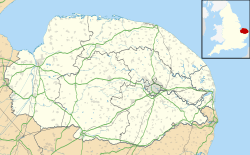Castle Acre Priory facts for kids

The extant remains of Castle Acre Priory church
|
|
| Monastery information | |
|---|---|
| Order | Benedictine |
| Established | 1089 |
| Disestablished | 1537 |
| People | |
| Founder(s) | William de Warenne, 2nd Earl of Surrey |
| Site | |
| Location | Castle Acre, Norfolk, England |
| Coordinates | 52°42′1.9″N 0°41′0.8″E / 52.700528°N 0.683556°E |
Castle Acre Priory was an important religious building in the village of Castle Acre, Norfolk, England. It was a priory for monks of the Cluniac order. The priory was dedicated to three saints: St Mary, St Peter, and St Paul.
It is believed that William de Warenne, 2nd Earl of Surrey started the priory in 1089. His father had founded England's first Cluniac priory in Lewes. The Cluniac order came from a region called Burgundy. The priory was first built inside Castle Acre Castle. However, this spot was too small for the monks. So, the priory moved to its current location in the castle grounds about a year later.
The priory closed down in 1537. Today, its ruins are looked after by English Heritage. You can also visit the nearby Castle Acre Bailey Gate and Castle Acre Castle.
Exploring Castle Acre Priory
The main church building was officially opened between 1146 and 1148. The Warenne family helped the priory a lot with money and gifts. Other people, like Scolland of Bedale, also gave generously. He was even buried there.
Castle Acre Priory was part of a larger network of monasteries. These monasteries followed the rules of the Abbot of Cluny. This abbot was based in France. Sometimes, this caused problems when England's kings were not friendly with France. To solve this, English Cluniac priories bought special legal recognition. This made them "native" English religious houses. About 20 to 30 monks lived at Castle Acre Priory.
The Priory's History and Ruins
The nave of the church is one of the oldest parts you can still see today. New sections were added to the priory over many years. However, all building stopped when the priory was closed in 1537. This happened during the time of King Henry VIII.
When the priory closed, King Henry VIII gave its lands to the Duke of Norfolk. The monks who lived there had to leave. Later, the estates went to Sir Edward Coke. Today, his descendant, the Earl of Leicester, owns the ruins. He also owns Castle Acre Castle.
The ruins are still very impressive. The large west front of the building is almost complete. The prior's lodging, where the head monk lived, is also in good condition.
Castle Acre Priory in Movies and TV
Castle Acre Priory has been a filming location for several productions.
- Scenes for the classic horror movie The Tomb of Ligeia (1964) were filmed here. This movie was directed by Roger Corman and starred Vincent Price.
- The priory was also used in the popular children's TV show Knightmare. In the show, it was called "The Ruins of Dungarth."
- You can also see the priory in the film Glorious 39.



